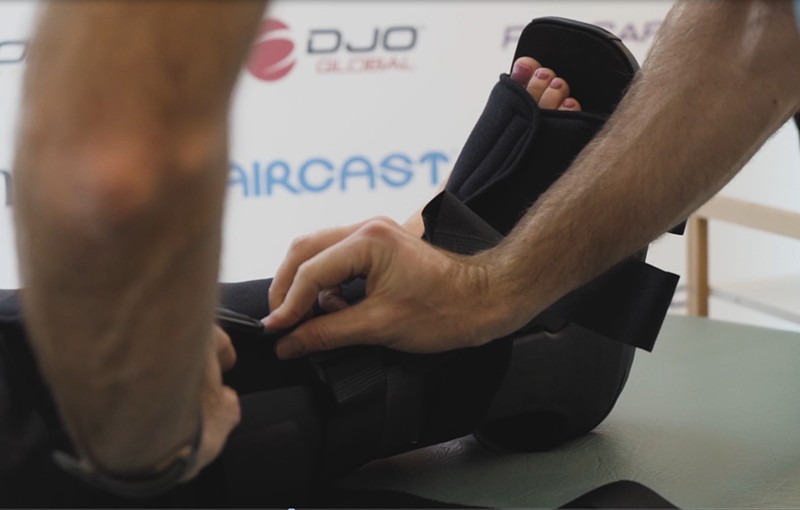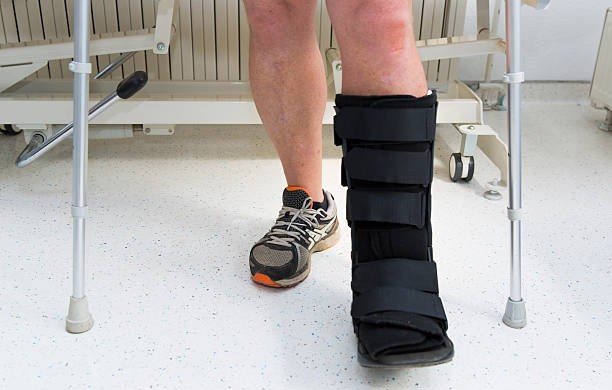Ankle Fracture
Distal Tibia and Fibula Fractures
The ankle joint is formed by the tibia, fibula and talus (bones) and surrounding these are a series of complex ligaments. Ankle injuries themselves are very common and on occasion an ankle fracture results in any or multiple of these bones. Ankles can also be fractured through many other traumatic incidents.
Due to the many combinations of fractures that can occur in this region we will mostly focus on the stable and conservatively managed ones. There are many ankle fractures to the above named bones that will require orthopaedic consultation and subsequent surgery. When any ankle injuries are suspicious of a fracture then an Xray will be a very important tool for assisting diagnosis which then dictates the specific management plan.
Distal Fibula Ankle Fracture
The fibula is the long bone on the outside of your lower leg. The pointy part at the ankle end of the fibula is also known as the lateral malleolus.
Isolated distal fibula fractures are ankle fractures that are considered stable can be managed conservatively. A classification system called the weber ankle fracture classification is used to categorise fractures in the lateral malleolus.
To be considered stable a fibula fracture location below the syndesmosis (ligament attaching the fibula and tibia) will be in the area where there is a vast amount of ligament support to an ankle and hence make it more stable. This would be classed as a weber A fracture. These fractures can be placed in a moon boot and allowed to weight bear as pain allows.

Isolated fibula fracture at the level of the syndesmosis is classed as a weber B also has subcategories (B1, 2, 3) depending on its extent. A simple fracture in this location (B1) can be managed in a moon boot but would be non-weight bearing for the initial period of healing. Weber C fractures are those that occur above the syndesmosis and as previously mentioned are likely to be unstable and therefore complex and would need further referral. Weber C’s also have 3 subcategories (C1,2,3).
Distal Tibia Ankle Fracture
The tibia forms the largest part of the ankle joint. The long shin bone is the shaft of the tibia and at the level of the ankle the tibia is the bony bump on the inside of your ankle called the medial malleolus.
As the tibia is the main weight bearing bone in the lower leg and ankle, an ankle fracture involving the tibia need to be looked at very closely. Simple undisplaced distal tibia fractures that are considered stable can be managed in a moon boot and may or may not be allowed to weight bear in the initial healing stages.
Distal tibia fractures with displacement or any other levels of complexity will need to be seen by an orthopaedic surgeon.
Ankle fractures may also involve the posterior malleolus at the back of the ankle formed from the tibia. Small and simple undisplaced fractures here can be managed conservatively in a moon boot. It is important to note that posterior malleolar fractures are often considered isolated and may not look bad on an Xray but are sometimes associated with a syndesmosis injury especially where there was a traumatic mechanism. Higher grade ankle syndesmosis injuries are considered unstable at the ankle and benefit from surgery.
Treatment for Ankle Fractures
Ankle fractures as with ankle sprains have a range of complications which need a reasonable amount of Physiotherapy rehabilitation during recovery to assist with return to normal function. The key to getting a good result after an ankle fracture (or any other fracture) and returning to full function is early management. Activate Physiotherapy offer same day appointments to attend their fracture clinic to ensure your distal radius fracture is managed with the best management from the start.
Following your Xray our Physiotherapists will fit you into a moon boot/walker. In most straight forward cases your ankle will be immobilised for a period of 4-8 weeks before being able to gradually increase your ability to walk.
Our approach is unique and our physiotherapists understand the importance of integrating your rehab during the healing process and will assist you with a rehabilitation program at the various stages of your healing journey. This reduces the complications that often occur from ankle fractures.
How to Make a Fracture Clinic Appointment
Making an appointment at our fracture clinic is as easy as booking online for your nearest Brisbane based Activate Physiotherapy clinic in Stafford or Gumdale.
No Xray? No problem!
We can arrange bulk-billed xrays to confirm diagnosis and monitor healing.
Need your cast removed?
We can help with that too! We are able to remove backslabs and full plaster or polyester casts.


